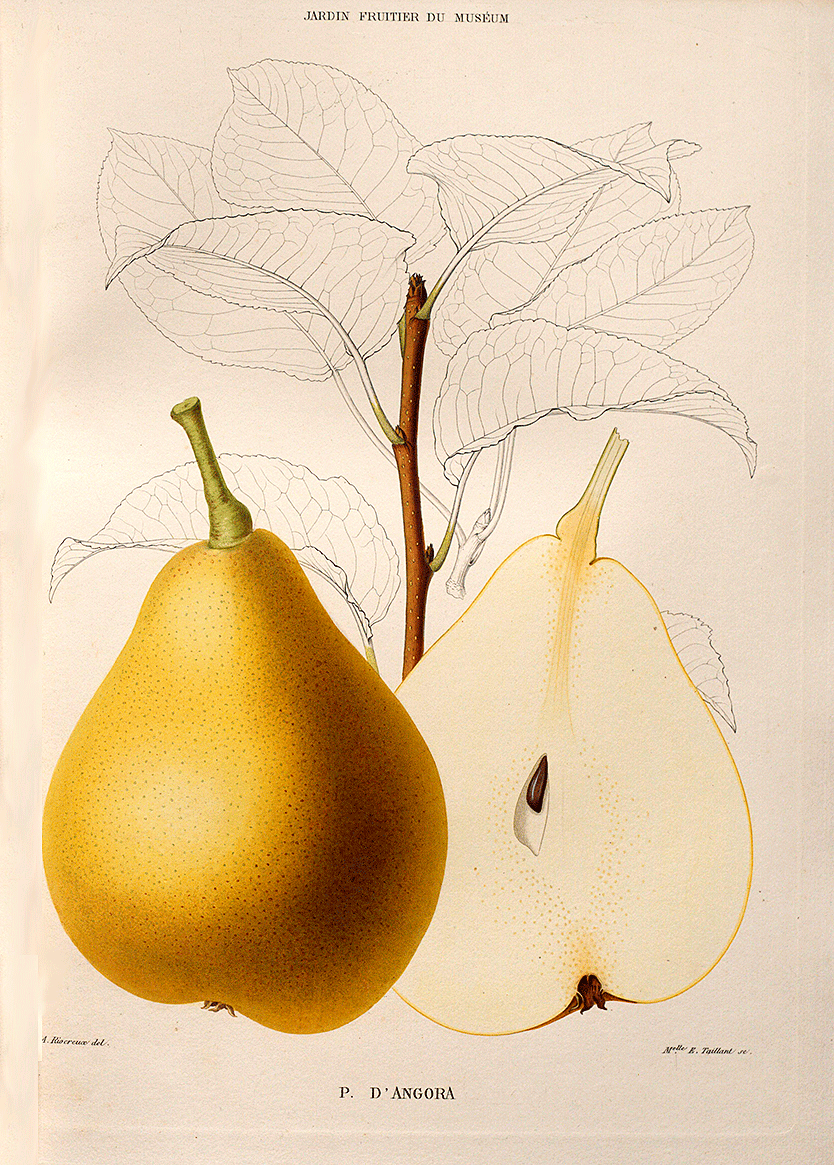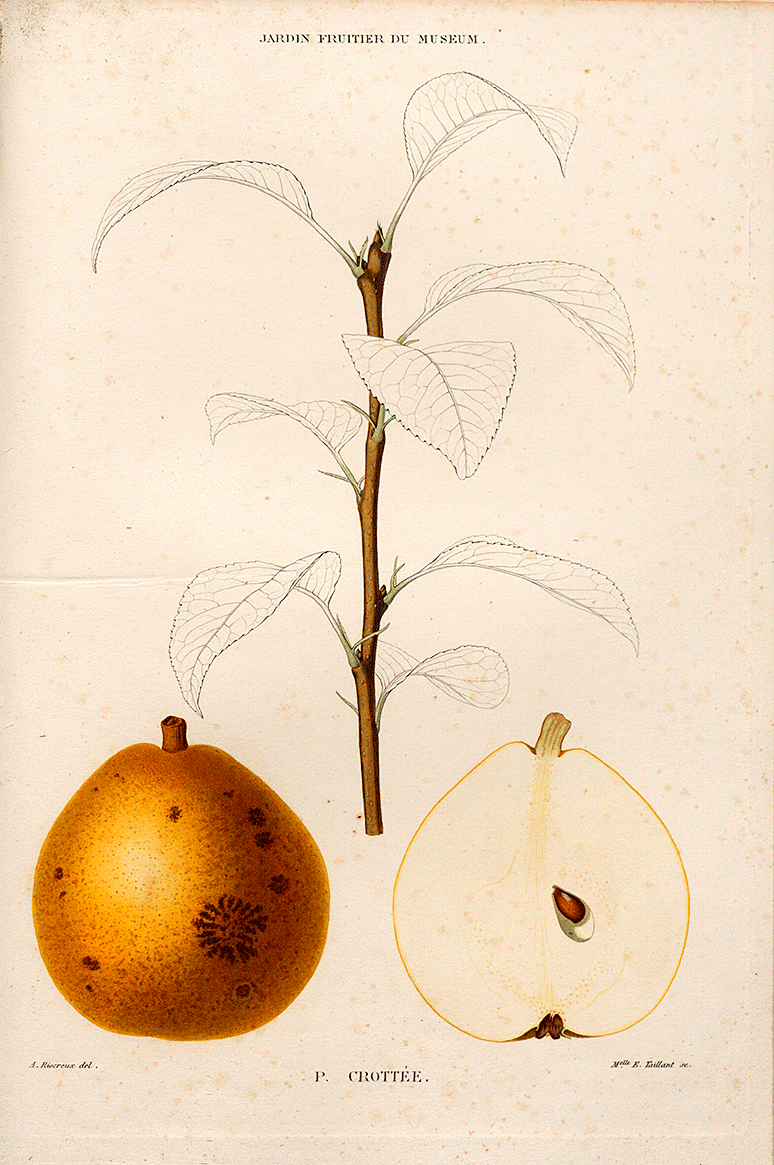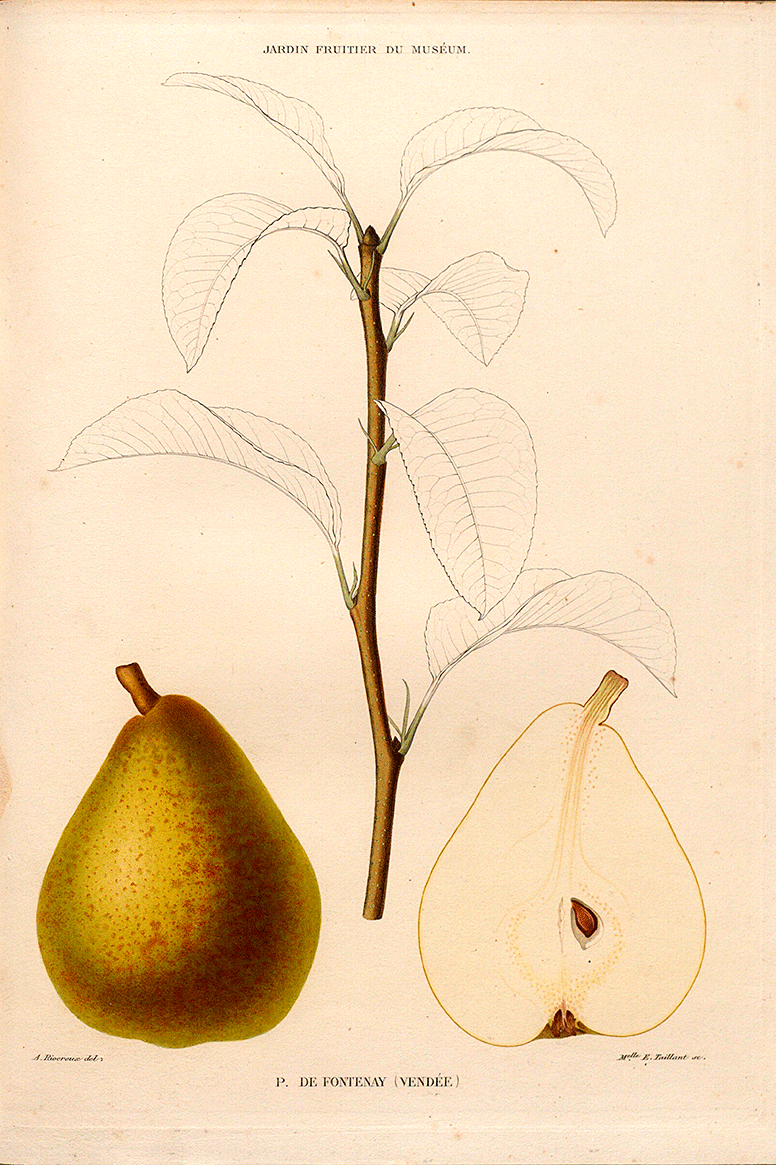To name a thousand times this marvel that is... the pear
Which do you prefer? The Duchesse d'Angoulême or the Muddied? The Frangipane, the Rocket, the Swiss Breeches or the Forest Melt? The exotic or the unusual, the rustic or the aristocratic? The romantic, perhaps? Let us take a stroll through the Museum Orchard!

A mouth-watering journey among words
In 1870, Joseph Decaisne published a voluminous collection entitled Le Jardin fruitier du Muséum, the Museum Orchard. The subtitle is delicious: "or Iconography of all the species and varieties of fruit trees grown in this establishment, with their description, history, synonymy, etc.". With a wealth of details we learn from this book historical anecdotes, or even matters of taste in the literal sense, to name a thousand times this marvel that is the pear, certainly good or bad, depending on the moods and the descriptive science of the time, which is incomparable.
From Amadotte to Amanlis...
Where we learn that the variety "Amadotte is flat, yellow, smooth, dry and musky, so called by the tree which was found in Burgundy, at Dame Oudotte's (with a pun), whose wild wood was all thorny". Unfortunately, its popular origin does not improve the general description in this unique catalogue: "Autumn fruit, with curved tail [...] firm, almost brittle flesh, not very tasty". Whereas the Poire Amanlis, which follows in the volume consulted, appears much more pleasant "with very delicate flesh, melting, sweet, very pleasant" It is true that it has a rather suggestive “oeil” or eye, charmingly described as “almost like a flower”. But what is this “eye”? It is simply "the side opposite the stalk, the remains of the flower whose sepals are often still visible". By the way, "ombilic” (umbilicus) or "cul” (butt) mean exactly the same thing!
By way of the exotic Angora and Dix...
The Angora pear comes from what is now Turkey: Mr. J.P. de Tournefort, a famous French botanist at the end of the 17th century, first observed it when he left Angora (hence its name) for Brousse, a town in this country: "The Beizabar stream [in a fairly narrow valley at an altitude of 850 metres] flows into the Aïala river after having ground a few mills and brought fertility to a number of areas divided into orchards and vegetable gardens. This is where the excellent pears come from, which are sold in Constantinople under the name of Angora pear". For the record, on 15 January 1833, a certain Mr Léon Leclerc, a former deputy from Mayenne, sent a letter to the President of the Académie des Sciences of the Institut de France, in which he explained the interest of this variety, unknown in France, and the fact that he would be able to bring a sample back to our country (along with an apple tree), thanks to a very "zealous" diplomat on the spot, a sample that he then regarded as a veritable treasure... The P. Dix, for its part, originated in the United States, according to what Mr. Decaisne gathered in 1854: "This pear has been designated under the name of Lewis Pear or Poire Louis, which is quite different [from the original name]. It is only in recent times, and as a result of information sent to us by our correspondents in the United States, that we have come to know the true name of this excellent pear, the mother tree of which is found in the garden of Mrs Dix, in Boston.”

Pear "d'Angora" design (Le Jardin fruitier du Muséum - 1871-1872).
Unusual and country varieties
There are also varieties with unusual names, such as the Poire Bon chrétien ordinaire or Good ordinary Christian pear, the poire d’Oeuf or Egg pear, the Poire Cent couronnes or Hundred Crowns pear, the Poire Crotté or Muddied pear, the Poire Bergamote or Bergamot pear, the Poire Culotte de Suisse or Swiss breeches pear, the Poire Calebasse or Calabash pear, or the Poire Fusée or Rocket pear, the latter of which can be identified by the shape of the fruit itself, or its colour. However, this beautiful shape does not necessarily make for a good pear, as is the case with the Fusée, which is classified as a "fruit for compote or for making Poires tapées, literally “slapped pears”, a traditional method to conserve the fruit by poaching, drying and subsequently flattening (slapping) it. The Poire Crottée gets its name from "round or fringed, black, squamous, hard and chapped marks that do not serve it well" (sometimes even called Galeuse or Mangy), while the Poire Frangipane, on the other hand, is appreciated for its taste in relation to this dessert. As for the name of the many Poires Beurré or Buttery Pears, which form an independent group, it derives from their texture, which "melts like butter in the mouth...". Note that the Poire de Baratte or Churn Pear has an interesting origin in connection with Norman butter...

Pear "Crottée" design (Le Jardin fruitier du Muséum, 1871-1872).
Names of places or persons
There is also no shortage of varieties referring to places or people, famous or not. The Poire Duchesse de Angoulême, the Poire Frédéric de Wurtemberg (a Renaissance prince), Poire Archiduc Charles (a well-known Belgian sovereign), Poire Comte de Flandre, Poire de Fontenay (Vendée) or de Nantes, d’Amboise, d’Auch, as well as Poire Bonne d'Ezée (Indre et Loire) and many more...
The Poire Epine du mas, on the other hand, "is native and truly indigenous to the country [Limousin region]; the wild tree that gave birth to it still exists in the forest of Rochechouart, and it takes its name from a village, Le Mas, close to this forest. Its general rating is very good, since it is a very good fruit, which is also recommended for its pleasant shape and beautiful colouring"... We should also mention the Poire d'Albret, Alexandrine Douillard, Graslin, St Michel Archange (St Michael the Archangel) or Conseiller à la cour (court counsellor)...

Pear "d'Auch" design (Le Jardin fruitier du Muséum, 1871-1872).

Pear "de Fontenay" design (Le Jardin fruitier du Muséum, 1871-1872).
The Romantics
And finally, it is too tempting to mention one last poetic or romantic category: The Fin or de septembre or Golden End of September is particularly distinguished by its marked bicolour aspect: for Mr H.L. Duhamel du Monceau, one of the greatest French agronomists and botanists of the 18th century: "Its skin is smooth, a plain, cheerful green on the shady side, bathed in red and interspersed as if with marbling on the sunny side. Its flesh is white, buttery and delicate.” The Poire Fondante des bois (Forest Melt) is also attractive to the eye, but it seems to have its downside when it comes to tasting: "I tasted this fruit too late to appreciate it properly" notes one of its detractors. As for the Brindamour (a little bit of love), it is a delightful name, is it not?

Pear "Fin Or de Septembre" design (Le Jardin fruitier du Muséum, 1871-1872).
What is the link with INRAE?
The Angélys pear was born in 2000 at the INRAE centre in Angers, after several decades of research in variety creation (the first crossbreeding was carried out in 1963), from a hybridisation between the Doyenné du Comice and Doyenné d'Hiver varieties. It is a winter pear remarkable for its quite unique flavour and fragrance, combined with a very good storage capacity. It is now marketed throughout France, and is grown in particular in many orchards in western France, where it has replaced the Passe-Crassane variety, decimated by the fire blight disease. It has recently been renamed "Angys".
To find out more : Bulletin interne de l'Institut National de la Recherche Agronomique (INRA), année 2000, p. 3-4. (in french)
Source
Le Jardin fruitier du Muséum « ou Iconographie de toutes les espèces et variétés d’arbres fruitiers cultivés dans cet établissement, avec leur description, leur histoire, leur synonymie, etc. », Decaisne, Joseph, Tome 4, 1871-1872. (The Museum Orchard “or Iconography of all the species and varieties of fruit trees grown in this establishment, with their description, history, synonymy, etc.". In French)
This work, kept at the INRAE centre in Angers (Volumes 1 to 6), is part of a set of 9 volumes on fruit growing published by the Muséum national d'histoire naturelle, the French National Natural History Museum, in 1870 and "published under the auspices of the Minister of Agriculture and Trade". All the illustrations in this focus are taken from volume 4. The first six volumes are devoted to the description of pear varieties, while volumes 7 to 9 describe peaches, plums, apricots and strawberries.
Text written by Olivier Dupré (INRAE, DipSO).
How to cite: Agate Focus: To name a thousand times this marvel that is... the pear, Olivier Dupré (INRAE-DIPSO), April 2023, https://agate.inrae.fr/agate/en/content/highlights



